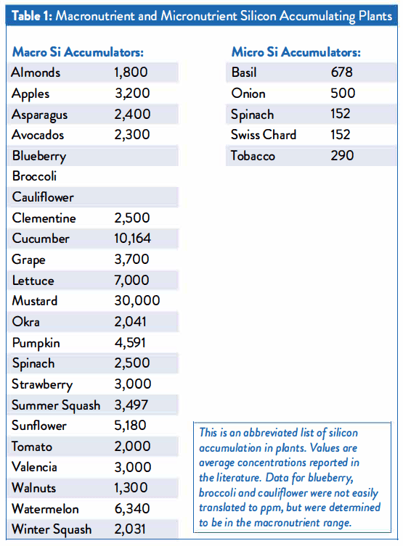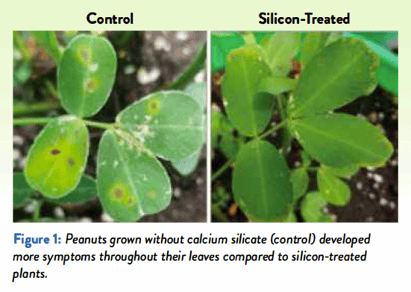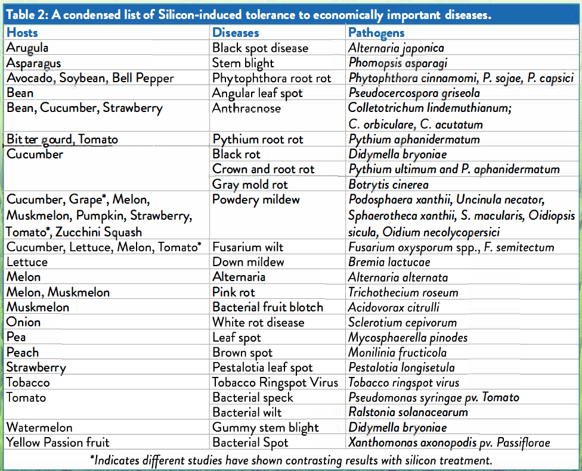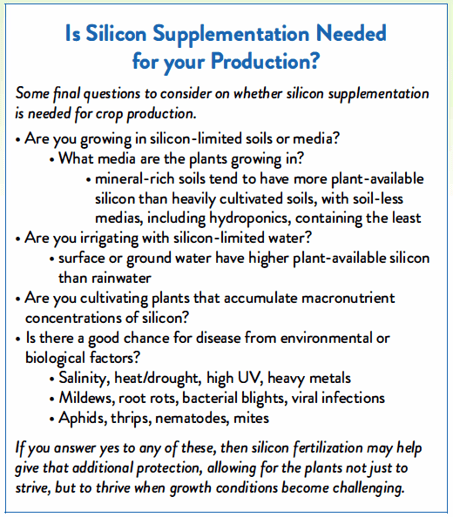By Wendy L. Zellner, Ph. D., The University of Toledo, Toledo, OH
 Silicon plays a critical role in plant health. Plants cultivated in limited silicon environment are more susceptible to biological pests and environmental stress. Silicon-fed plants are not just physically stronger, their internal immune response, or physiology, is enhanced. This allows them to respond and adjust to the adverse growing conditions more quickly, indicating the significance of this nutrient in the plant's defense response.
Silicon plays a critical role in plant health. Plants cultivated in limited silicon environment are more susceptible to biological pests and environmental stress. Silicon-fed plants are not just physically stronger, their internal immune response, or physiology, is enhanced. This allows them to respond and adjust to the adverse growing conditions more quickly, indicating the significance of this nutrient in the plant's defense response.
To begin, all plants absorb and accumulate silicon. Current descriptions give a misdirected view that most plants accumulate low concentrations of silicon. Essential nutrients are categorized as either macronutrient (containing greater than 1,000 ppm) or micronutrients (containing less than 1,000 ppm).
Using these same parameters, silicon is a macronutrient for tomato, which is often referred to as a low-accumulator or silicon excluder. Even plants that accumulate silicon as a micronutrient, such as basil, tobacco, and onion, have enhanced stress tolerance when adequate silicon is supplied. At the other end of the spectrum are the hyperaccumulators, rice and sugarcane, that accumulate up to 10% Si in their leaves. This, however, seems to be the exception, not the norm. Most monocots and over 70% of reported dicots accumulate silicon in their leaves at macronutrient concentrations (Table 1). When plants are cultivated in silicon-limited environments, they become more susceptible to disease whether they accumulate silicon as a macro- or micronutrient.

Silicon's role in defense goes beyond the physical barrier theory and likely involves physiological changes in cellular contents of silicon treated plants. Tolerance to foliar pathogens with silicon treatment is the most dramatic and is easily visible to the naked eye (Fig. 1). 
Interestingly, scientist are finding out the reduction of fungal diseases is not due to failure of the pathogen to gain entry into the plant, but as a result of changes in the plants' internal environment, limiting adequate materials, such as sugars, amino acids and organic molecules, that would support development and spread of the infection. There are many reviews in the literature highlighting the protective role in plant-pathogen interactions for a wide range of fruits and vegetables (Table 2). Bacterial and viral infections are also managed more efficiently when plants are grown with adequate silicon.

Similar to findings for fungal and bacterial diseases, insect herbivory is also drastically reduced in silicon-treated plants. For some insect-host relationships, penetration events are not reduced, while feeding time and egg counts are lower. Damaged areas are also reduced in non-phloem feeding herbivores. This again suggests that silicon-fed plants have changes to their internal environment, reducing the viability of these insects.
Silicon protection does not just stop at biological agents, but also helps with environmental stress, such as salinity, drought, temperature extremes, and heavy metal stress. Most of these events lead to water and nutrient imbalances. When plants have adequate silicon, they can adjust their internal environment to negate water loss, while dealing with these adverse conditions. This is often observed with reduction in transpiration as well as reduced levels of malondialdehyde (MDA), a marker for lipid peroxidation that correlates to oxidative stress. Enzymes and hormones also change between control and silicon-treated plants, but their pattern of change is not always similar when studies are compared. Even with these contradictions in enzymatic and hormone concentrations, the end result is that plants return more quickly to an internal balance, or homeostasis, with silicon treatment.

Post-harvest protection in both fruits and vegetables is another benefit of silicon. In these cases, the fruit or vegetable is dipped in higher concentrations of silicon, usually in the form of liquid potassium- or calcium silicates. This leads to a longer shelf life with reduction in many of the diseases that afflict produce during storage. Apples, avocados, carrots, lemons, and strawberries have all shown post-harvest protection. Reduction in ethylene and CO2 and increases in cytokinins are likely involved in the response.
Silicic acid and silica nanoparticles are two known forms of plant-available silicon. They can be supplied through a number of products that include both liquid and solid fertilizers, depending on the production styles. Since plants need available silicon at the time of stress, ensuring a continual supply in the growing media or through foliar applications provides protection to the previously listed situations. While the mode of action for silicon protection is still unclear, its positive benefits to plant health is undeniable.
This article appeared in the August 2020 issue of CAPCA Adviser Magazine. You can read the original here.




